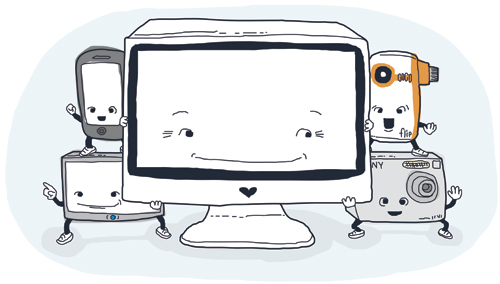Where did you get that bright and shiny digital literacy?
Recent policy papers call for the support of community digital literacy providers, including community-based organizations, but there is little appreciation for the variety and richness of these organizations’ work. The Aspen Institute and Knight Foundation’s “Digital Literacy: A Plan of Action” admits there is “little awareness of programs and services in digital and media literacy education,” and recommends the mapping of community digital and media literacy resources. A framework for digital and media literacy training [pdf] having been established, the next question is, who is providing this kind of training anyway?

Having administered a national service corps for ten years, the Transmission Project has a unique perspective on the field of public media, and alongside the Center for Media Engagement, it is already mapping public media organizations, many of which serve as media and digital literacy providers in their communities. From this vantage point, we can see that the organizations delivering media and digital literacy training may not be seen as literacy organizations first and foremost, and many explicitly literacy-oriented institutions in fact address a variety of needs.
At Latinitas in El Paso, TX, digital literacy is being taught to Latina girls and young women through activities that promote cultural pride. These activities range from arts-and-crafts projects to digital picture-taking to creative journalism; they are primarily aimed at fostering a sense of identity and self-worth and inspiring discussion around issues like immigration, which youth learn about from various news sources. However, as Latinitas youth participate in program activities, they also engage with a variety of technologies that allow them to share their own perspectives in multiple ways. Latinitas’ website hosts two youth-published magazines. Youth create audio recordings and tie them to what they have written in relevant ways. Participants use Flip cameras to record and download digital video they take themselves. Latinitas serves the functions of media and digital literacy by creating critically thinking, civically engaged consumers and creators of media as it addresses the unique concerns of young Latina women.
Based in Albuquerque, NM, the Media Literacy Project runs similar youth programs, such as its Digital Justice for Us campaign, in which inner-city youth video-record their interviews with peers from rural areas with poor broadband infrastructure. However, youth media programming has not always been a primary focus of MLP; story sharing and media making have only recently become priorities. Traditionally, MLP has cultivated media literacy through teaching participants how to analyze and deconstruct manipulative media messages, especially advertisements. MLP has always gotten participants to take responsibility for and play a more active role in the media, but only in recent years has the organization provided community members the tools as well as the skills to share their perspectives and recruited their help to assure that the entire community maintains its right to a public voice.
Media Literacy Project’s new approach can be attributed to the fact that as comprehensive digital and media literacy has come to connote the use of new technologies, the MLP has had to extend its work to securing fair access to and affordability of those technologies if it is to continue to provide a useful service to its community. The necessary extension of Media Literacy Project’s work into a new realm reveals another blind spot of the current literature. Studies rightly assert that media literacy calls for not only effective use of new technologies, but also comprehension of the “social, cultural and ethical issues that go along with the use of these technologies.” More often than not, though, the same studies provide only vague notions of the far-reaching work such a comprehension would ultimately demand. For many organizations that serve marginalized populations, this means showing community members the social and economic opportunities that technology represents and then mobilizing communities for the purposes of securing access and affordability.
As definitions of literacy expand to accommodate new technologies, the work of organizations necessarily expands to address the social issues that attend those technologies. The Transmission Project supports these organizations because the multifaceted nature of their work – their ability to serve communities as they adapt to changing times – makes them prime recipients of capacity building and maximizes the impact that the addition of a Digital Arts Service Corps member makes.
Special Thanks
Christie McAuley, Community Education Coordinator, Media Literacy Project
MLP receives funding from the New Mexico Department of Health’s Tobacco Use Prevention & Control Program (TUPAC) to provide health education and tobacco prevention programs around media. Christie oversees the administration of this and similar media education programs.
Leticia Miranda, Digital Arts Service Corps Member
Community Outreach Coordinator, Media Literacy Project
Leticia directed and produced a counter-ad to Verizon’s Rule the Air campaign. The video was aired this past November 16 at a Future of the Internet Townhall with FCC Commissionaer Michael Copps, hosted by the Media Literacy Project, Center for Media Justice, and Free Press.
Candelario Vazquez, Digital Arts Service Corps Member
Media Justice Organizer, Media Literacy Project
Cande organized the Digital Justice 4 Us youth program.
Marisol Guzaman, Digital Arts Service Corps Member
Program Development Coordinator, Latinitas
Marisol creates volunteer training manuals and develops and refines a collection of over 100 lessons and activities for clubs and afterschool programs.
The Aspen Institute Communications and Society Program, Digital and Media Literacy:
A Plan of Action, Washington, D.C.: The Aspen Institute, November 2010.
| Attachment | Size |
|---|---|
| Transmission Project's Approach to Digital Literacy.pdf | 43.01 KB |
| happyTools_web.jpg | 61.25 KB |



Comments
Post new comment